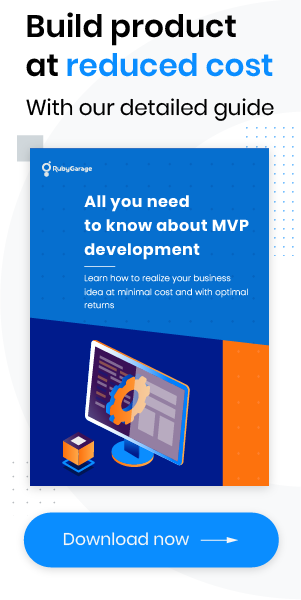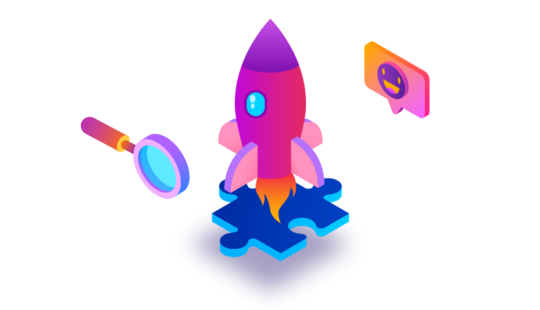-
Product Management
Software Testing
Technology Consulting
-
Multi-Vendor Marketplace
Online StoreCreate an online store with unique design and features at minimal cost using our MarketAge solutionCustom MarketplaceGet a unique, scalable, and cost-effective online marketplace with minimum time to marketTelemedicine SoftwareGet a cost-efficient, HIPAA-compliant telemedicine solution tailored to your facility's requirementsChat AppGet a customizable chat solution to connect users across multiple apps and platformsCustom Booking SystemImprove your business operations and expand to new markets with our appointment booking solutionVideo ConferencingAdjust our video conferencing solution for your business needsFor EnterpriseScale, automate, and improve business processes in your enterprise with our custom software solutionsFor StartupsTurn your startup ideas into viable, value-driven, and commercially successful software solutions -
-
- Case Studies
- Blog
How to Prioritize MVP Features: 9 Useful Approaches
Creating a minimum viable product (MVP) allows you to test your business idea fast and with minimal resources. However, creating an MVP isn’t as easy as it may seem. Since you’re limited in the number of features you can implement in an MVP, you need to choose those that your potential clients are most interested in. Want to find out how to implement the right functionalities in your MVP? Keep reading.
Why you need to carefully define and prioritize MVP features
You shouldn’t choose the functionalities for your product MVP spontaneously or purely based on intuition. It requires deep research and analysis to define those MVP features that will cover the urgent needs of your potential users. These are the major reasons you should define and prioritize features for your MVP:
To create a unique product
Defining and prioritizing features for your MVP helps you make sure you aren’t reinventing the wheel. When devoting all your attention and energy to product development, you must ensure that your product provides unique solutions that no one has provided before.
To create a product that’s in demand
The reason that 42% of startups fail is lack of market demand. Startup founders often overestimate the importance of their products. The problem you wish to solve with your product may not be vital for potential users. Insufficient market research may lead to little or no market demand.
To create a product that helps you achieve your business goals
Creating a good product is not enough. As soon as you realize there’s a market for your product, you need to concentrate on the product’s quality. If you don’t include the features your users are waiting for, your solution may not be enough to fully solve their problems. Thus, without prioritizing features, you may fail to achieve your business goals and meet users’ expectations.
To hit the market as soon as possible
The primary purpose of creating an MVP is to test your business idea in the shortest possible time. You need to deliver your MVP fast with as few resources as possible. Prioritizing features helps you identify what functionality you need to start working on as soon as possible to reduce the time to market and what functionalities may be added later in production.
Prioritizing MVP features requires effort. To help you do it, we’ll let you know how to define features for your MVP and show you some useful ways to prioritize them.
How to define features for your MVP
The functionalities your MVP needs are determined by many factors. Let’s see what steps you must take to successfully define the features that will cover your users’ needs.
Identify the target audience
Identifying the target audience is one of the most crucial steps for a business. Before developing a software product, you need to create user personas based on your potential customers’ demographics including gender, age, education, and job title.
Find out their biggest issues
People use software products when they need to solve specific problems. Think about your target audience’s problems and pain points. Identify what your potential customers may struggle with in their everyday lives or at work. You can identify your potential customers’ pain points by researching expert opinions, interviewing your target audience, conducting surveys, and role playing.
Decide how your product will solve users’ issues
Find out how your product can address your target audience’s needs and pain points. Your software system should allow clients to get a desirable solution with minimal effort. The more efficiently your product can solve problems, the more valuable it is. For example, if your prospects’ pain points are primarily financial, you could highlight the features of your product within the context of a lower monthly subscription plan.
Learn how customers solve their issues right now
Researching how your potential customers currently solve the problems you’ve identified can help you determine if those problems are crucial or if you’d better concentrate on solving more urgent issues. Moreover, this step may help you discover that the product you were going to create already exists and that your idea needs to be optimized to compete in the market.
Research who your direct competitors are
Find out what companies offer a similar solution to your target audience. Examine their products and define their strengths and weaknesses to know what they lack and what you can implement in your MVP to provide a better solution.
For instance, current music streaming apps that are competitors - Spotify and YouTube Music both offer free plans, yet Spotify lets users with free plans listen to music with the smartphone screen turned off, and economize battery charge. This might be one of the tiny things that may help them overcome their competitor. As people say, “the devil’s in details”.
Research who your indirect competitors are
In addition, search for competitors that provide different products but still may satisfy your target audience’s needs. You should investigate their products’ advantages and disadvantages in the same way as those of direct competitors.
Define killer features
Analyze all functionalities of your product and identify the ones that make it unique and add value.
For example, the killer feature of the Domino’s pizza app that was launched in 2016 is no feature at all. How is it possible? Users order their favorite pizza with zero clicks just by opening the app. The only feature present in the app is a ten second countdown that is needed to cancel an order if the app was opened by mistake.
Form a unique value proposition
Your product should have something special that will help it stand out from other similar products. With the help of prioritization, you can choose the right functionalities to create a one of a kind product. This will give potential customers a reason to use specifically your product. Thus, a possibility to order a taxi only with one tap and with no phone calls allows Uber to complete 14 million trips each day.
Adopt a user-centered development mindset
When creating a successful product that’s useful to clients and beneficial for your business, always keep the end users in mind during development. This will give you a better understanding of your target audience’s needs and pain points and allow your team to create a useful product.
As soon as your list of functionalities for your product MVP is ready, it’s time to prioritize them.
How to prioritize features for your MVP
Below, we list nine useful approaches your team can apply to prioritize the feature list for your MVP.
MoSCow matrix
This is a prioritization method that involves dividing all MVP features into four groups: must have, should have, could have, and won’t have this time. The must have group includes mandatory functionalities. The should have group comprises functionalities that are not vital but still significant. The could have group consists of nice to have functionalities. And the won’t have this time group includes functionalities that are not a priority at the moment but may be added later.

Numerical assignment
This method is also called grouping, as it’s based on distributing product functionalities between priority groups such as critical priority, moderate priority, and optional priority. The names of these groups may vary. The important thing is that these groups should be clearly defined and understood by all stakeholders.
When using the numerical assignment method, each group has a numerical value. For example, number 1 stands for critical priority functionalities, number 2 stands for moderate priority functionalities, and number 3 stands for optional functionalities
Let’s see how this looks with the example of a taxi app.

Bubble sort technique
This method helps you sort functionalities from the most to the least important. It entails writing down a whole set of MVP functionalities in an array, comparing two adjacent ones, and changing their place in the array according to their importance. This process involves several iterations. With each iteration, the highest priority functionalities come to the top of the array, just like water bubbles rise to the surface of the water.
Let’s look at how it works.
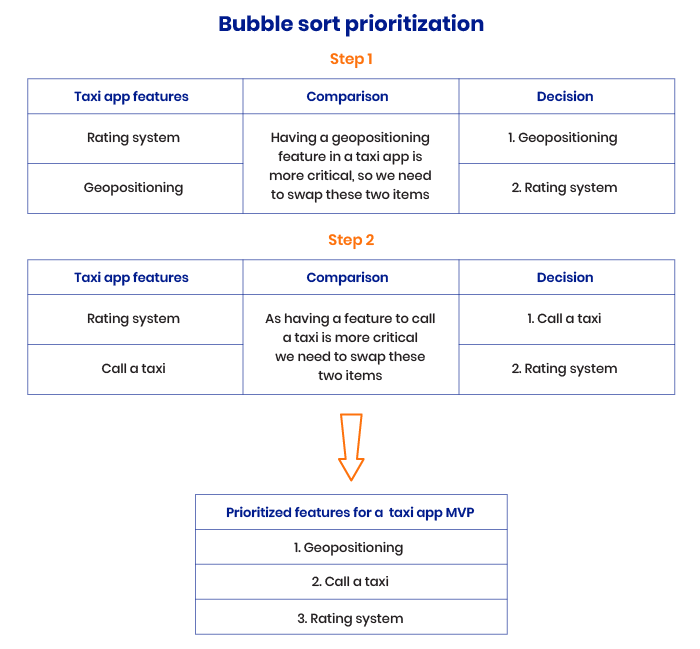
Effort and impact technique
This method may also be called value and complexity technique. It helps you prioritize MVP features by analyzing the effort their implementation requires and the impact they have on the final product and customer experience. The results of the analysis are then represented in a matrix.
Each feature is assessed in two ways: its value, which means the value it will bring to your user personas, and the value it’s anticipated to bring to your company. Also, the team assesses the complexity of implementing each of those functionalities, which may include operational costs, development hours, and risks involved.
Once the feature is scored, it’s mapped on the chart which we display below with effort or complexity and value or impact of the features visualized.
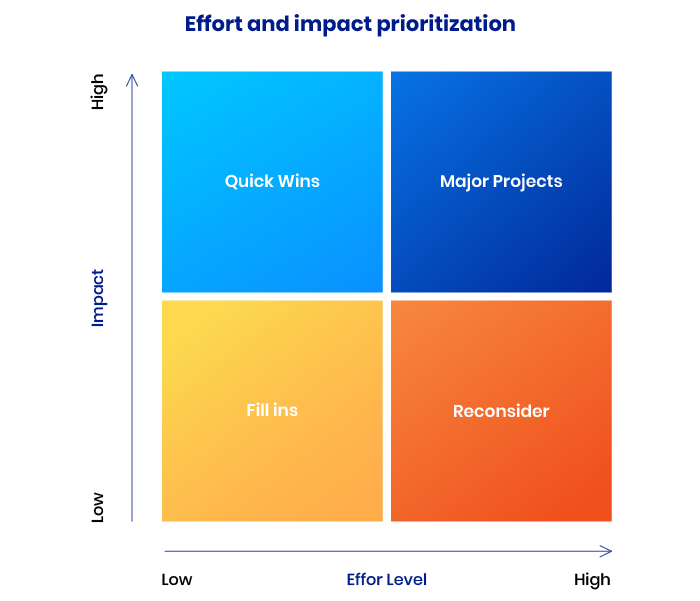
Opportunity scoring technique
This technique involves communication with end users. Specifically, it involves asking potential customers about the functionalities they think would be the most important in the product you’re going to develop and asking them to assess their satisfaction with these same functionalities in existing products. The functionalities that get a high score in importance and low score in satisfaction are your opportunities. If you implement those functionalities in a way that satisfies the needs of end users, you’re likely to get many customers.
The Kano model technique
The Kano model is a user-centered approach to feature prioritization. It outlines three types of product features: threshold attributes, which are the basic features users expect your product to have; performance attributes, which aren’t necessary but significantly influence the users’ satisfaction; and excitement attributes, which clients do not even expect but are delighted when they get.
The Kano matrix shows how a product’s functionality affects customer satisfaction.
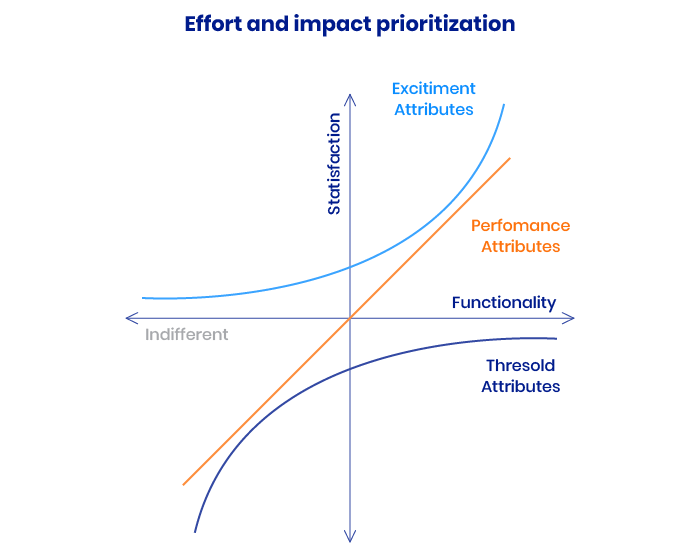
According to this technique, a product with only basic functionalities can’t do much to satisfy a customer. Having only basic functionality may lead your customers to feel indifferent about the product. To please users, you need to implement high-performance and exciting functionalities.
To identify functionalities that will help you reach high customer satisfaction, you need to get feedback from your target audience with the help of thorough market research, surveys, and focus groups.
After receiving feedback, you need to analyze the results, brainstorm all possible functionalities for your product, and classify them into four groups: threshold, performance, excitement, and irrelevant. Make sure you implement all the required threshold functionalities, and don’t forget to include several performance and excitement functionalities to please your customers.
Speed boat method
Speed boat is an agile method that helps you prioritize product functionalities through collaborative play with stakeholders. This method uses the metaphor of a boat to think of possible difficulties the team is going to face during development. During the brainstorming session and discussion, the product, symbolized by the boat (which may actually be drawn on a whiteboard), should find a way to the island (the goal to be achieved; in our case an MVP release), identify the functionalities that speed up the boat by blowing the wind in sails (essential functionalities that help users solve their problems and provide solution to company’s business goals), and determine the anchors (the functionalities that slow down the boat and prevent success - these may be the functionalities that are not crucial for an MVP release and that do not solve the customers cornerstone issues). During collaborative discussions, you can identify the functionalities that may need to be postponed to later releases and the functionalities you need to concentrate on.
User story mapping
User story mapping involves creating a detailed outline of a user’s interaction with the planned product. This method helps predict users’ actions and identify the features customers will seek. User story mapping is a powerful instrument of an MVP definition since it lets all kinds of stakeholders take part: business owners (sponsors), engineers, designers, product managers, and sales representatives.
As the first step, the team considers the goals that users want to achieve by using the prospective solution. Let’s take a taxi app as an instance. For example, for a taxi app, the user goals may be to define a route, pay for a ride, wait for a taxi, and leave post-ride feedback.
Next, each user goal is divided into activities that a user has to perform in order to achieve a specific goal: these may include entering the departure point, choosing the destination, selecting a vehicle type and payment method, viewing the arrival time, communicating with the driver, and finally leaving a review.
Then, each activity is subdivided into user stories: actual small tasks that a user performs that create value. Each member of the team writes a story in the following format: As a [type of user], I want to [action] so that [benefit / value].
As soon as the user stories are ready, the customer goals and activities should be mapped. User stories should be mapped to the corresponding activities in a shortened format starting from the stories that outline the highest priority functionalities and continuing in descending order of feature priority.
As a result, we get a map of usage sequence, where the horizontal axis means the usage sequence, or a usage flow - what activities are performed in what sequence to achieve a goal. The vertical axis represents the criticality or priority - how important these tasks are for each specific activity.
After user story mapping is complete, the functionalities should be distributed into several releases by, for instance, separating them with a line.
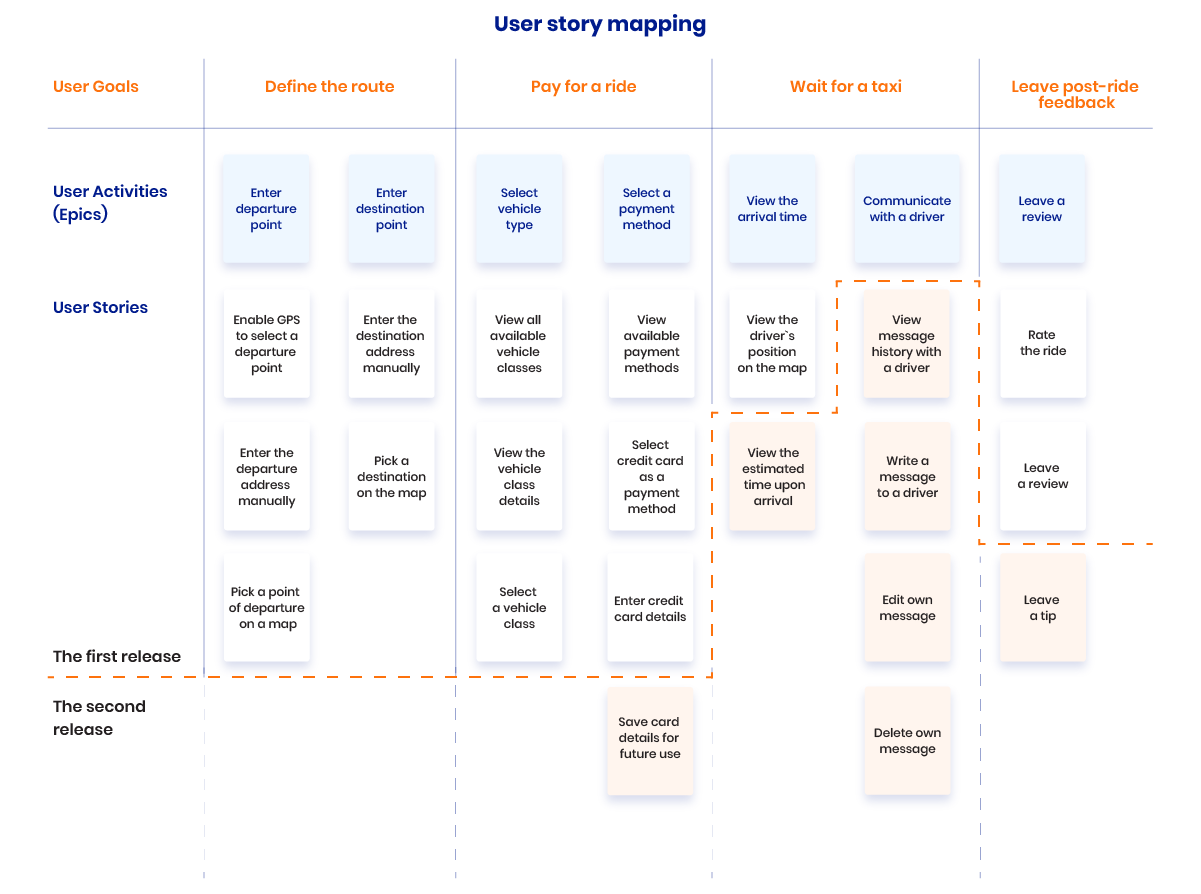
Recap
When creating an MVP, avoid relying on what you think might delight your future customers. Conduct a thorough analysis and take a proper approach to prioritize features instead.
FAQ
-
- To create a unique product
- To create a product that’s in demand
- To create a product that helps you achieve your business goals
- To hit the market as soon as possible
-
- Define your target audience
- Find out their biggest issues
- Decide how your product will solve these issues
- Learn how customers solve these issues right now
- Research who your direct competitors are
- Research who your indirect competitors are
- Define killer features
- Form a unique value proposition
- Adopt a user-centered development mindset
-
You can use the following methods for this purpose:
- MoSCoW matrix
- Numerical assignment
- Bubble sort technique
- Effort and impact technique
- Opportunity scoring technique
- Kano model technique
- Speed boat method
- User story mapping
If you’re looking for a team to help you develop an MVP and launch it on the market, contact RubyGarage. Let’s make your MVP together.






